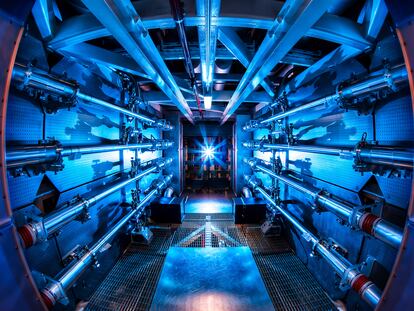How ‘ignition’ works: Instructions for replicating the energy of the stars
A nuclear fusion experiment at a US national lab reached a milestone on the path to producing clean and almost endless energy, although commercial applications are still a long way off
In a milestone for nuclear fusion, a laser experiment at the Lawrence Livermore National Laboratory in California has managed to produce more energy than the amount delivered by the beam that caused the reaction. Ignition, the process of triggering a nuclear reaction that creates more energy than it consumes, was achieved at the atomic level in this experiment, representing a new step towards realizing the old dream of an abundant energy source without CO2 emissions.

This is how nuclear fusion
to create clean energy works
1
192 lasers beams are focused on a small cylinder in which there is a capsule with hydrogen atoms inside.
Laser beams
Cylinder
(hohlraum)
1 cm
Capsule with
hydrogen
atoms
2
Heat and pressure trigger the fusion of the hydrogen isotopes, replicating the process that powers the Sun and other stars.
Laser beams
+
+
Isotope 1
+
+
Isotope 2
3
The fusion creates a helium nucleus and a leftover mass that becomes energy.
+
Helium
+
+
Energy
+
Neutron

This is how nuclear fusion to create clean energy works
Laser beams
Cylinder
(hohlraum)
1
192 lasers beams are focused on a small cylinder in which there is a capsule with hydrogen atoms inside.
1 cm
Capsule with
hydrogen
atoms
Laser beams
+
2
Heat and pressure trigger the fusion of the hydrogen isotopes, replicating the process that powers the Sun and other stars.
+
Isotope 1
+
+
Isotope 2
+
Helium
+
3
The fusion creates a helium nucleus and a leftover mass that becomes energy.
+
+
Energy
Neutron

This is how nuclear fusion to create clean energy works
Laser beams
Laser beams
Cylinder
(called hohlraum)
Isotope 1
1 cm
Capsule with
hydrogen
atoms
Isotope 2
2
1
Heat and pressure trigger the fusion of the hydrogen isotopes, replicating the process that powers the Sun and other stars.
192 lasers beams are focused on a small cylinder in which there is a capsule with hydrogen atoms inside.
Helium
3
The fusion creates a helium nucleus and a leftover mass that becomes energy.
Energy
Neutron
The simultaneous firing of 192 powerful laser beams against a capsule smaller than the nail on your pinky finger generated a temperature of three million degrees Celsius and an enormous pressure that made hydrogen atoms overcome their natural repulsion and merge to form helium atoms, releasing energy in the process. Both the beam and the release of energy lasted a fraction of a second.
Although the energy delivered by the laser beam to the capsule was less than that produced by the fusion, the energy necessary to produce that beam, due to the inefficiency of the lasers, is still much greater than what was generated by the union of the hydrogen nuclei.

Facility required for nuclear fusion
1
To achieve fusion, 192 laser beams are guided through a series of amplifiers and mirrors measuring 1,500m to increase their power.
Target
chamber
In a few microseconds, the laser beams see their energy multiplied millions of times as they are guided to the target chamber.
2
Target
chamber
Cylinder
(hohlraum)
3
Inside the target chamber, the laser pulses are transformed into ultraviolet energy and focused on the target: a hollow cylinder called a hohlraum where the hydrogen atoms will merge.
Cylinder
(hohlraum)
1 cm
Capsule with
hydrogen
atoms

Facility required for nuclear fusion
1
To achieve fusion, 192 laser beams are guided through a series of amplifiers and mirrors measuring 1,500m to increase their power.
California
CALIFORNIA
USA
Laboratory
San Francisco
Lawrence Livermore
National Laboratory
50 km
250 meters
Target
chamber
2
3
Inside the target chamber, the laser pulses are transformed into ultraviolet energy and focused on the target: a hollow cylinder called a hohlraum where the hydrogen atoms will merge.
In a few microseconds, the laser beams see their energy multiplied millions of times as they are guided to the target chamber.
Target
chamber
Cylinder
(hohlraum)
1 cm
Cylinder
(hohlraum)
Capsule with
hydrogen
atoms

Facility required for nuclear fusion
1
To achieve fusion, 192 laser beams are guided through a series of amplifiers and mirrors measuring 1,500m to increase their power
California
Lawrence Livermore
National Laboratory
CALIFORNIA
USA
Laboratory
San Francisco
50 km
250 meters
The goal of this 250m laboratory is to recreate the pressure and temperature conditions inside the Sun and the stars.
Target chamber
2
3
Inside the target chamber, the laser pulses are transformed into ultraviolet energy and focused on the target: a hollow cylinder called a hohlraum where the hydrogen atoms will merge.
In a few microseconds, the laser beams see their energy multiplied millions of times as they are guided to the target chamber.
Cámara
de destino
Cylinder
(hohlraum)
1 cm
Cylinder
(hohlraum)
Capsule with
hydrogen
atoms
To get an idea of the amount of energy that nuclear fusion can produce if the extensive technical hurdles that still exist are one day overcome, about the same amount of energy could be extracted from one liter of water as from 300 liters of oil.
Unlike fission, which throws neutrons at very heavy atoms like uranium to split them and release energy, fusion merges light atoms for the same purpose. In the first case, in addition to energy, large amounts of radioactive material are also produced, which in some cases can be dangerous for thousands of years. With fusion, the neutrons released in the process contaminate the reactor materials, but managing that waste would be easier, although it would still need to be stored for about a century.
Sign up for our weekly newsletter to get more English-language news coverage from EL PAÍS USA Edition
